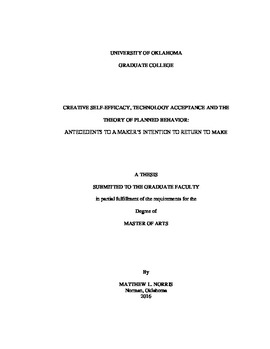| dc.contributor.advisor | Kisamore, Jennifer | |
| dc.contributor.author | Norris, Matthew | |
| dc.date.accessioned | 2016-12-20T22:08:22Z | |
| dc.date.available | 2016-12-20T22:08:22Z | |
| dc.date.issued | 2016-12 | |
| dc.identifier.uri | https://hdl.handle.net/11244/47110 | |
| dc.description.abstract | Fab Labs, Makerspaces and Hackerspaces are part of a decentralized global Do-It-Yourself movement providing unique resources to tinkerers, hobbyists, inventors and artists to make almost anything. Individuals who use these facilities are often called “makers.” This preliminary research offers insight into why people intend to return to making by testing a proposed Maker Behavioral Model based on the Theory of Planned Behavior, the technology acceptance model, and creative self-efficacy. This model proposes three key characteristics which predict an individual’s intentions to continue making, namely social interactions, creative behaviors, and perceived behavioral control. A survey of the membership of Fab Lab Tulsa and other U.S.-based Fab Labs was used to test the maker model by examining the members’ attitudes and behaviors about creativity and making, technology, their social group, their openness to experience, and their creative role identity. It also examined the correlation with their intention to return to make. The results demonstrate that perceived behavioral control is the biggest predictor of maker intention, followed by creative behaviors and social interactions. Technology perceptions were related to social interactions but did not predict intention. This preliminary research has implications for any Fab Lab that seeks to bolster its membership, improve its staffing or increase facility usage. Future work should include development of the survey for non-English speakers and non U.S. cultures. | en_US |
| dc.language | en_US | en_US |
| dc.rights | Attribution-NonCommercial-ShareAlike 3.0 United States | * |
| dc.rights.uri | https://creativecommons.org/licenses/by-nc-sa/3.0/us/ | * |
| dc.subject | maker | en_US |
| dc.subject | fab lab | en_US |
| dc.subject | creativity | en_US |
| dc.subject | theory of planned behavior | en_US |
| dc.subject | digital fabrication | en_US |
| dc.subject | Psychology, Industrial. | en_US |
| dc.subject | Psychology, Behavioral. | en_US |
| dc.subject | Engineering, General. | en_US |
| dc.subject | makerspace | en_US |
| dc.subject | hackerspace | en_US |
| dc.title | Creative Self-Efficacy, Technology Acceptance, and the Theory of Planned Behavior: Antecedents to a Maker's Intention to Return to Make | en_US |
| dc.contributor.committeeMember | Steinheider, Brigitte | |
| dc.contributor.committeeMember | Hellman, Chan | |
| dc.date.manuscript | 2016-12-09 | |
| dc.thesis.degree | Master of Arts | en_US |
| ou.group | College of Arts and Sciences::Department of Psychology | en_US |
| shareok.nativefileaccess | restricted | en_US |

